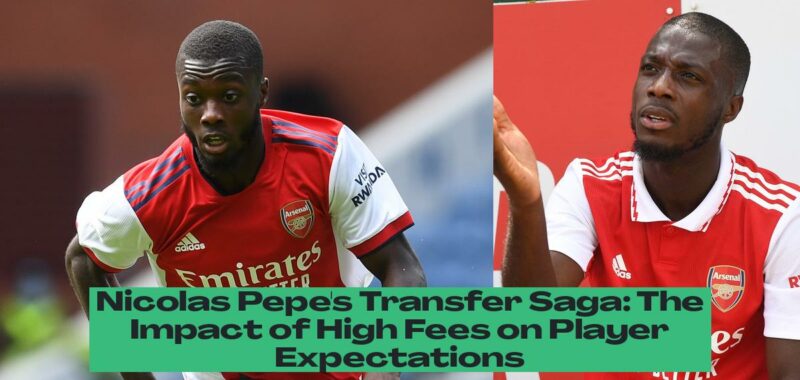The Price Tag of Expectations: Nicolas Pepe’s Transfer Saga and the Burden of High Fees
The world of football is a captivating mix of skill, strategy, and, of course, money. Transfers, those high-stakes moves between clubs, often become the focal point of fan discussions and media frenzy. But what happens when a player doesn’t live up to the astronomical price tag attached to their name? This is the story of Nicolas Pepe and the heavy weight of expectations that came with his record-breaking transfer to Arsenal.
In 2019, Arsenal made a bold statement by securing the services of Nicolas Pepe from Lille for a then-club record fee of £72 million. The Ivorian winger had proven his worth in Ligue 1, showcasing his dazzling dribbling skills and lethal finishing abilities. However, his move to the Premier League presented a whole new set of challenges.
- Nicolas Pepe faced immense pressure and scrutiny due to his high transfer fee of £72 million to Arsenal.
- The burden of justifying a significant financial outlay can be overwhelming for players, especially when adapting to a new league and style of play.
- The intense media attention and constant comparisons to his price tag added to Pepe’s struggles in replicating his stellar form from Ligue 1.
- Adapting to the physicality and intensity of the Premier League posed challenges for Pepe beyond justifying his transfer fee.
- Pepe’s lack of consistency in converting his talent into goals and assists contributed to his difficulties at Arsenal.
The Pressure Cooker: How High Transfer Fees Impact Player Performance
The moment Pepe stepped onto the Emirates Stadium pitch, the weight of that hefty transfer fee seemed to weigh heavily on his shoulders. While the club had structured the payments to Lille in a staggered manner, the initial £72 million figure was a constant reminder of the investment made in him. It’s no secret that high transfer fees can create a pressure cooker atmosphere for players, leading to immense expectations and scrutiny.
The burden of justifying such a significant financial outlay can be overwhelming, especially for a young player navigating a new league and adapting to a different style of play. Pepe, despite his talent, found himself struggling to replicate the form that had made him a star in France. The high-pressure environment, the intense media attention, and the constant comparisons to his price tag undoubtedly contributed to his difficulties.
Beyond the Price Tag: A Deeper Look at Pepe’s Time at Arsenal
While the high transfer fee certainly played a role, it’s important to look beyond the financial aspect and analyze Pepe’s performance in a holistic manner. The Premier League is renowned for its physicality and intensity, and adapting to this new style of play can be challenging for any player, regardless of their price tag. Pepe’s lack of consistency and his inability to consistently translate his talent into goals and assists on a regular basis ultimately led to his departure from Arsenal.
It’s also worth noting that Arsenal’s tactical approach during Pepe’s time at the club might have hindered his development. The team’s overall style of play didn’t always favor his attacking abilities, and his role within the squad seemed to fluctuate. This lack of a defined role and consistent opportunities to shine further hampered his progress. Pepe’s case highlights the complex interplay between player talent, team dynamics, and the expectations that come with a high transfer fee.
The Player’s Perspective: Pepe’s Take on the High Price Tag
Pepe himself has acknowledged the pressure that came with his exorbitant transfer fee. He has spoken about the impact of the price tag on his performance, stating that it “kind of set him up to fail.” He has also acknowledged that he didn’t always look like a good player during his time at Arsenal, comparing his performances to those of Bukayo Saka, who has shown more consistency and polish.
Pepe’s words resonate with the reality of the situation. High transfer fees can create a self-fulfilling prophecy, where the pressure to justify the investment becomes a burden on the player, leading to anxiety and self-doubt. Pepe’s experience serves as a reminder that football is a team sport, and the success of any player is dependent on a multitude of factors, including the coaching staff, team tactics, and the overall team dynamic.
The Lille Perspective: A Different View on the Transfer
The Lille owner, however, paints a contrasting picture. He has publicly stated that Arsenal did NOT overpay for Pepe, arguing that another club had offered even more money for the winger. This perspective highlights the complex nature of transfer negotiations, where clubs often engage in a bidding war to secure the services of highly sought-after players.
The Lille owner’s statement sheds light on the competitive nature of the transfer market and the influence of inflated prices on the overall valuation of players. While Arsenal’s decision to pay a record fee for Pepe may have been influenced by market pressures, ultimately, it was their investment that brought him to the Emirates Stadium.
The Aftermath: Pepe’s Departure and the Legacy of the High Transfer Fee
Pepe’s time at Arsenal ultimately ended with his contract being terminated by mutual consent. He received a substantial sum of money as part of the termination agreement, signaling the high value placed on him by both the player and the club.
Pepe’s departure, however, leaves a lingering question: how much of his struggles were due to the pressure of the high transfer fee, and how much was down to other factors? While the price tag undoubtedly created a challenging environment, it’s unfair to solely blame it for his lack of success at Arsenal.
Lessons Learned: The Importance of Context and Understanding
Pepe’s story serves as a cautionary tale about the complexities of high transfer fees and their impact on player performance. It emphasizes the importance of context and understanding when evaluating a player’s success or failure.
High transfer fees create immense pressure, but they do not guarantee success. The player’s individual abilities, the team’s tactical approach, and the overall environment within a club all play crucial roles in shaping a player’s career trajectory.
The case of Nicolas Pepe serves as a reminder that evaluating a player’s worth and performance requires a nuanced approach that considers all the factors at play. High transfer fees are a reality of the modern game, but it’s crucial to remember that they are not the sole determinant of success or failure.
Looking Ahead: The Future of High Transfer Fees in Football
The debate surrounding high transfer fees is likely to continue in the future. As the global football market continues to expand, with clubs vying for the best talent, we can expect to see even higher transfer fees being paid for top players.
It is essential that clubs, players, and fans alike engage in thoughtful discussions about the implications of these extravagant transactions. We need to move beyond the hype surrounding high transfer fees and focus on creating a more sustainable and balanced approach to the transfer market.
The future of football hinges on finding a way to balance the financial aspects of the game with the inherent passion and love for the sport. It’s a delicate dance, but one that requires careful consideration and a shared commitment to ensuring that the game remains enjoyable for all involved.









